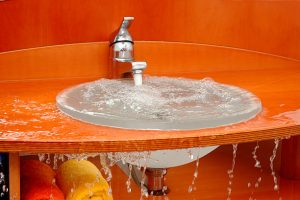Few things are as frustrating as an over flowing sink. Water pours out of the drain, quickly filling up the basin and threatening to overflow onto the floor.
If you don’t know what to do, the water can quickly spread throughout your kitchen and cause a lot of damage. This is a real emergency that most homeowners don’t prepare for.
Here are some emergency tips for dealing with an over flowing sink:
First, Turn Off the Water at the Source

When dealing with an over flowing sink, plumbing experts at Mackinandsons plumbing recommend you turn off the water at the source.
- Turf off your sink taps to avoid more water from coming in
- If your sink has a pop-up stopper, close it to prevent water from flowing out
- Locate your home’s main water valve and shut off the flow of water into your home
This will stop more water from coming in and causing more damage. It’s important to know where your main water shut-off valve is located and have tools like a wrench to turn the valve. Ensure you have emergency plumbing tools on hand just in case.
Assess the Situation and Decide What to Do Next
Once the water is turned off, take a step back and assess the situation. Is the sink overflowing with just water, or is there grease and food particles mixed in?
If it’s just water, you may be able to fix the issue by simply removing the plug and letting the water drain out. Or if there is grease or food mixed in, you’ll need a different approach.
If you have a plunger handy, place it over the drain and push and pull until the water starts to drain. If that doesn’t work, use a plumber’s snake.
This is a long, flexible tool you can insert into the drain to help clear any clogs. Of course, you also need to have these tools on hand to deal with such emergencies.
Start Dealing With the Mess

Depending on how much water is involved, you may want to start by mopping up as much of it as possible. If there’s a lot of water, use towels or even buckets.
Pay attention to how much water has seeped onto the floor and whether it has soaked into your tiles, hardwood, or carpet floors. If it has, you’ll need to take extra care to dry it out completely to avoid mold or mildew buildup.
Once you’ve cleaned the bulk of the water, assess the damage and figure out how to fix the problem.
Depending on what’s causing your sink to overflow, you may be able to fix the problem yourself. Water can cause serious damage to floors, so it’s important to clean it up as quickly as possible.
Locate the Source of the Problem
Now, it’s time to focus on the source of the problem. In most cases, an overflowing sink is caused by a clogged drain. You can fix this by using a plunger as mentioned above or removing the drain trap to clear the blockage. If this doesn’t work, there could be a bigger problem, such as a blockage further down the drainpipe.
That means it’s time to call a professional plumber to take a look and fix the issue. They’ll quickly identify the problem and restore your sink to working order.
Prevent an Overflowing Sink

In the meantime, you can do a few things to prevent an over flowing sink from happening again.
- Be mindful of what you’re putting down the drain
- Avoid pouring grease or oil down the drain
- Avoid putting eggshells, coffee grounds, or other food waste down the sink
- Use your garbage disposal properly, and don’t put too much food waste down at once
- Never pour chemicals down the drain- this can damage your pipes and cause other problems
With these tips, you can avoid an over flowing sink and enjoy a well-functioning kitchen. But if the worst does happen, now you know how to deal with it.




